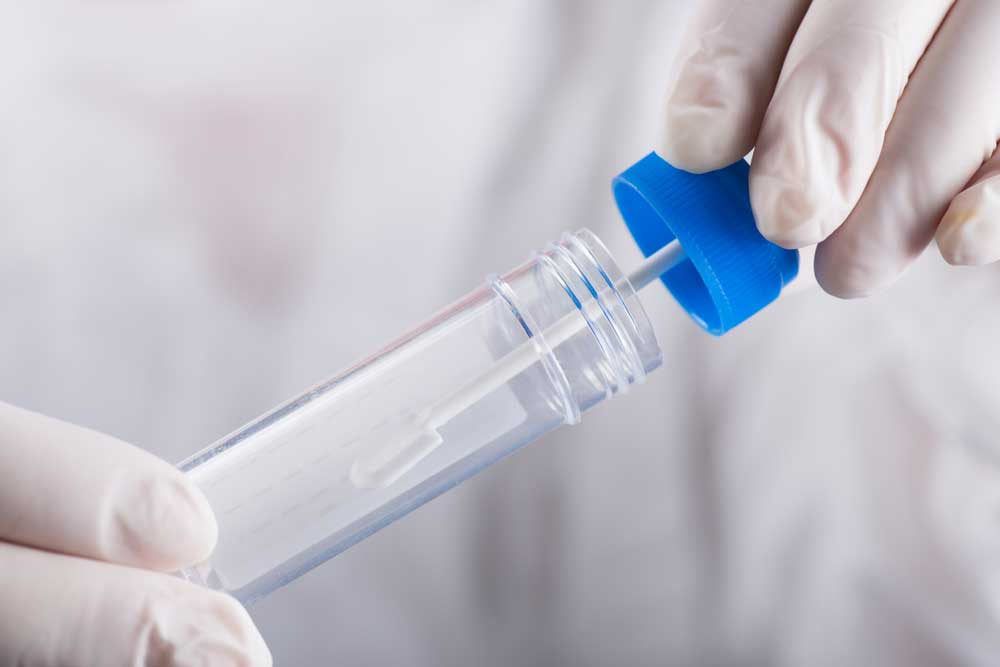Functional Lab Testing
Gut Health Test / Functional Medicine Testing / Functional Lab Testing
A gut health test like the GI MAP helps to identify contributing factors to why you may be experiencing obvious GI symptoms as well as seemingly unrelated symptoms. Read more about GI Map test results here (or see a potion of my personal results here). Additional functional medicine testing like the DUTCH test, Vibrant Wellness Zoomer testing and the OATS test can expose other triggers or imbalances that might be contributing to unpleasant or debilitating symptoms as well. The reason we use functional lab testing when appropriate, is to help us get an overall picture of what’s going on inside the body that’s contributing to your specific imbalances so we have a starting place to work from without guessing. See below for a list of the most common tests used.

DSL-GI-MAP
The Diagnostic Solutions Laboratory GI Microbial Assay Plus (“GI-MAP”) a 1-day stool test includes markers for gluten sensitivity (anti-gliadin IgA), inflammation in the gut (calprotectin), immunity in the gut (SIgA), pancreatic enzyme sufficiency (elastase), and occult blood. It also looks for the presence of pathogens – including H Pylori and other bacteria, parasites, worms and viruses – in the gastrointestinal tract. To detect pathogens, the lab uses Real-time polymerase chain reaction (RT-PCR), or quantitative PCR (qPCR), which combines amplification and detection into one step. qPCR “is one of the most powerful and sensitive gene analysis techniques available to detect the DNA of microorganisms.
COST: $390
MARKERS INCLUDED ON THIS TEST:
- Bacterial Pathogens (Campylobacter, C difficile Toxin A & B, EHEC, E coli 0157, EIEC/Shigella, ETEC LT/ST, Salmonella, Shiga-like Toxins, Shigella, etc.)
- Parasitic Pathogens (Cryptosporidium, Entamoeba histolytica, Giardia)
- Viral Pathogens (Adenovirus, Norovirus, Rotavirus)
- H pylori (H Pylori, with 7 virulence factors)
- Normal Bacterial Flora (Bacteroides Fragilis, Bifidobacter, Enterococcus, E. coli, Lactobacillus, Clostridium Spp., Enterobacter Spp.)
- Phyla Microbiota (Bacteroidetes, Firmicutes, Bateroidetes/Firmicutes ratio)
- Opportunistic Bacteria (Bacillus, Enterococcus, Morganella, Pseudomonas, Staphylococcus, Streptococcus, etc)
- Autoimmune Triggers (Citrobacter, Klebsiella, Mycobacterium tuberculosis, Prevotella Copri, Proteus Spp etc)
- Parasites (Blastocystis hominis, Dientamoeba fragilis, Endolimax nana, Entamoeba coli, Chilomastix mesnelli, Cyclospora, Pentatrichomonas)
- Fungi/Yeast (Candida albicans, Candida spp., Geotricum spp., Microsporidia spp., Rodotorula spp.)
- Viruses (Cytomegalovirus, Epstein Barr Virus)
- Worms (Ancylostoma duodenale, Ascaris lumbricoides, Necator americanus, Trichuris trichiura, Taenia spp)
- Additional Tests (Elastase, Steatocrit, SIgA, Anti-Gliadin, Calprotectin, b-Glucuronidase, Occult Blood)
- Antibiotic Resistance Genes
Vibrant Wellness Wheat Zoomer:
The Vibrant Wellness Wheat Zoomer Test assesses sensitivity to wheat, autoimmune disease, and intestinal barrier stability. If you suspect you have wheat sensitivity, multiple food sensitivities, intestinal permeability, autoimmune disorders, or chronic inflammation, you may benefit from this panel.
COST: $270
MARKERS INCLUDED ON THIS TEST:
- Celiac HLA Genetics (DQ2, DQ8)
- Celiac Panel – Total IgG, Total IgA, Transglutaminase 2 IgG, Transglutaminase 2 IgA, DGP IgG, DGP IgA
- Intestinal Permeability Panel – Zonulin, Anti-zonulin IgG, Anti-zonulin IgA, Anti-Actin IgG, Anti-Actin IgA, Anti-LPS IgA, Anti-LPS IgG + IgM
- tTg/DGP Complex – tTG/DGP Fusion Peptide IgG, tTG/DGP Fusion Peptide IgA
- Transglutaminase Panel – Transglutaminase 3 IgG/IgA, Transglutaminase 6 IgG/IgA
- Wheat Germ Panel – Wheat Germ Agglutinin IgG/IgA
- Gliadin Panel – Alpha Gliadin IgG/IgA, Alpha-Beta Gliadin IgG/IgA, Gamma Gliadin IgG/IgA, Omega Gliadin IgG/IgA, Gluteomorphin IgG/IgA, Prodynorphin IgG/IgA
- Wheat Allergy Panel – Wheat Allergen IgE
- Glutenin Panel – HMW Glutenin IgG/IgA, LMW Glutenin IgG/IgA
- Non-Gluten Wheat Panel – Serpin IgG/IgA, Farinins IgG/IgA, Amaylase/Protease Inhibitors IgG/IgA, Globulins IgG/IgA, Purinin IgG/IgA
DUTCH Complete Hormone Test—DUTCH Adrenals + DUTCH Hormone Metabolites Profiles + Melatonin
This test provides you with detailed information on how adrenal and sex hormones are being produced AND metabolized in the body. DUTCH stands for Dried Urine Test for Comprehensive Hormones.
COST: $300
The DUTCH Complete now includes the following additional markers:
- Homovanillate (HVA) – the primary dopamine metabolite
- Vanilmandelate (VMA) – the primary norepinephrine and epinephrine metabolite
- 5-hydroxyindoleacetate (5HIAA) – the primary serotonin metabolite
- Methylmalonate (MMA) – elevated if patients are vitamin B12 deficient
- Xanthurenate – elevated if patients are vitamin B6 deficient
- Pyroglutamate – elevated if patients are glutathione deficient
Mosaic OAT—Urine Organic Acids Testing:
Mosaic Organic acids are products of the body’s metabolic pathways. Evaluation of these downstream metabolites from various metabolic pathways provides insight into important areas related to gut health like fungus and mold, mitochondrial dysfunction, neurotransmitter status, indicators of detoxification and macronutrient breakdown and nutritional status. This makes organic acid testing a valuable tool to assess the functional need for essential nutrients, diet modification, antioxidant protection, detoxification, and other therapies.
COST: $330
The OAT test report is organized into clinically useful categories including:
- Intestinal Microbial Overgrowth Markers: Evaluates for Candida activity, Clostridia bacteria toxins, potential mold exposure, and imbalances in gut microflora.
- Oxalate Metabolites: Provides insights into the levels of oxalates, which could be generated by organisms within the system or through dietary intake.
- Glycolytic Cycle Metabolites and Mitochondrial Markers: Includes Krebs Cycle and Amino Acid Metabolites. Assesses metabolic efficiency, such as the use of glucose and amino acids for energy generation, and mitochondrial dysfunction.
- Neurotransmitter Metabolites: Evaluates the metabolism of phenylalanine, tyrosine, and tryptophan. These are linked to neurotransmitter status and quinolinic acid production.
- Pyrimidine Metabolites & Ketone and Fatty Acid Oxidation Markers: Provides insights into folate status and cellular turnover. Assesses mitochondrial utilization of fatty acids for energy production.
- Nutritional Markers: Offers insights into the sufficiency of essential vitamins, antioxidants, and metabolic pathway co-factors.
- Indicators of Detoxification: Assesses the presence of oxidative stress through markers of glutathione sufficiency. Evaluates methylation versus transsulfuration functions.
Vibrant Wellness Micronutrient Panel:
The Micronutrient Panel assesses direct measurement of both intra- and extracellular nutrient status of common vitamins, minerals, co-factors, amino acids, essential fatty acids, and more. If you are diagnosed with or suspect you have a chronic inflammatory condition, autoimmune disease (Celiac, Crohn’s, etc.), or any condition associated with nutrient malabsorption, you may benefit from this panel.
COST: $420
Nutrient Deficiencies can be associated with these symptoms:
- Stress
- Fatigue
- Depression or anxiety
- Numbness or tingling in extremities
- Weakened immune system
- Lack of concentration/Brain fog
- Neurological symptoms (impaired memory, confusion, ataxia, loss of balance, tremors)
MYCOTOXIN TESTING:
MOSAIC MYCOTOXIN: $310
Mycotoxins, produced by certain mold species, are some of the most prevalent toxins and can come from many sources, including buildings, vehicles, and food. These compounds have been recognized as a growing global health concern due to their acute and chronic adverse health impacts. Mycotoxin exposure can be challenging to diagnose without proper testing due to vague and often varied symptoms.
The MycoTOX Profile® is Mosaic Diagnostics’ most comprehensive assessment of mycotoxins. Our state-of-the-art urine-based assay accurately assesses levels of 11 different mycotoxins, including Aflatoxin M1, Ochratoxin A, Zearalenone, and Trichothecenes. The MycoTOX Profile® has been designed to help clinicians uncover mycotoxin exposure and guide a therapeutic strategy for prevention and treatment.
VIBRANT WELLNESS MYCOTOXIN: $400
The Mycotoxins panel measures levels of mycotoxins produced by common molds that people are exposed to. Mycotoxin exposure can come from both dietary and environmental sources. Dietary sources include spoiled or rotten foods, grains, dried fruits, nuts, coffee, and spices. Environmental sources include living or working in water-damaged buildings, airborne or physical contact with outdoor molds, and airborne dust in buildings containing mold spores. If you were diagnosed with or suspect toxic burden, impaired immunity, autoimmune disease, or exposure to mold, this panel may benefit you.
Oxford Biomedical MRT Leap—Food Sensitivities Testing:
Through a blood draw this tests for hidden inflammatory responses to 150 different foods and food-chemicals. This test provides insight into inflammation provoking foods and food chemicals and identifies the best foods for the individual. It is not dependent on antibody reactions (IgG, IgA, etc). (This test has be done outside of NY.)
Thyroid Comprehensive Testing:
Through a blood draw this test includes the following markers:
MARKERS INCLUDED ON THIS TEST:
Find Blood Draw Locations HERE
- TSH
- Free T3
- Free T4
- T4 Total
- Thyroglobulin
- Thyroxine-Binding Globulin
- Anti-Thyroglobulin Ab
- Anti-TPO Ab
